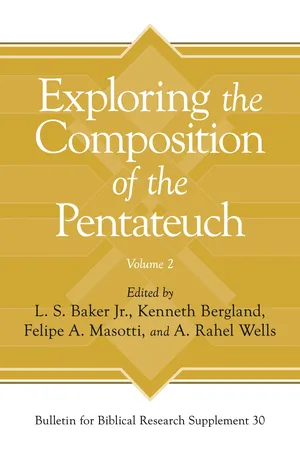
Exploring the Composition of the Pentateuch, Volume 2
- 299 pages
- English
- PDF
- Available on iOS & Android
Exploring the Composition of the Pentateuch, Volume 2
About this book
While the critique of existing approaches to the composition of the Pentateuch has its place, the editors of this volume argue that there is a need to formulate positive proposals based on verifiable data and logical argumentation. Building on the foundation established in the preceding volume, Exploring the Composition of the Pentateuch, Volume 2 pursues this goal by addressing three essential questions: What are key strategic areas of research that need attention? In what areas can we draw conclusions? And what are the limits of available, relevant evidence?
Part 1 of this volume investigates the readability of the Pentateuch, exploring narrative techniques, inconsistencies, and coherence. Part 2 tackles issues relevant for the dating of Deuteronomy, like the narrative retelling in Deut 1–3, dating based on parallels to the Loyalty Oath of Esarhaddon, and deuteronomistic tribal language. And part 3 focuses on issues related to the overall dating of the Pentateuch, discussing empirical models, comparisons with the Hazor Legal Fragments, turning points in pentateuchal scholarship, the direction of dependence between the legal material of the Pentateuch, and the absence of Zion theology in the Pentateuch.
In addition to the editors, the contributors include Richard E. Averbeck, John S. Bergsma, Joshua Berman, Daniel I. Block, Mark Steven Francois, Roy E. Gane, Richard S. Hess, Benjamin Kilchör, Noel K. Weeks.
Frequently asked questions
- Essential is ideal for learners and professionals who enjoy exploring a wide range of subjects. Access the Essential Library with 800,000+ trusted titles and best-sellers across business, personal growth, and the humanities. Includes unlimited reading time and Standard Read Aloud voice.
- Complete: Perfect for advanced learners and researchers needing full, unrestricted access. Unlock 1.4M+ books across hundreds of subjects, including academic and specialized titles. The Complete Plan also includes advanced features like Premium Read Aloud and Research Assistant.
Please note we cannot support devices running on iOS 13 and Android 7 or earlier. Learn more about using the app.
Information
Table of contents
- COVER Front
- Copyright Page
- Table of Contents
- Introduction
- Chapter 1: Case Studies of Some Apparent Inconsistencies in the Pentateuch
- Chapter 2: Contradiction, Coherence, and Composition
- Chapter 3: Sophisticated Narrative Technique of the Pentateuch
- Chapter 4: The Coherence and Internal Rationale of the Priestly Legislation in the Pentateuch with Special Attention to the “Guilt Offering
- Chapter 5: Selective Literary Representation of Vassal Obsequiousness and Responsive Awareness in the Amarna Letters, the Hittite Treaty Prologues, and Deuteronomy 1–3
- Chapter 6: Borrowed Curses : The Loyalty Oathof Esarhaddon, Deuteronomy 28:20–44,and a Premonarchic Date for the Earliest Edition of Deuteronomy
- Chapter 7: The Tribes of Israel (Part 1) : Their Significance for Assessing the Provenance of the Book of Deuteronomy
- Chapter 8: The Tribes of Israel (Part 2) : Their Significance for Assessing the Provenance of Deuteronomy 33
- Chapter 9: The Biblical Criticism of Ibn Hazmthe Andalusian : A Medieval Control for Modern Diachronic Method
- Chapter 10: Questions Concerning the Covenant Code in Light of the Hazor Legal Fragments
- Chapter 11: Three Turning Points in Research History Toward a Farewell to the Mosaic Origin of the Pentateuch: How Strong Are They
- Chapter 12: Direction of Dependence in the Animal‑Related Sabbath Laws in the Pentateuch
- Chapter 13: Did Postexilic Judaism Really Abandon Jerusalem and the Temple? A Discussion with Jean Louis Ska on the Absence of Zion Theology from the Pentateuch
- Index